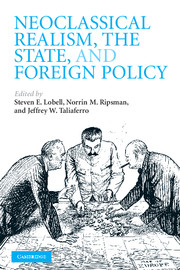Book contents
- Frontmatter
- Contents
- List of figures
- List of tables
- List of contributors
- Acknowledgments
- 1 Introduction: Neoclassical realism, the state, and foreign policy
- 2 Threat assessment, the state, and foreign policy: a neoclassical realist model
- 3 Neoclassical realism and strategic calculations: explaining divergent British, French, and Soviet strategies toward Germany between the world wars (1919–1939)
- 4 Neoclassical realism and identity: peril despite profit across the Taiwan Strait
- 5 Neoclassical realism and the national interest: presidents, domestic politics, and major military interventions
- 6 Neoclassical realism and domestic interest groups
- 7 Neoclassical realism and resource extraction: State building for future war
- 8 Neoclassical realism and state mobilization: expansionist ideology in the age of mass politics
- 9 The limits of neoclassical realism: additive and interactive approaches to explaining foreign policy preferences
- 10 Conclusion: The state of neoclassical realism
- Index
- References
10 - Conclusion: The state of neoclassical realism
Published online by Cambridge University Press: 05 June 2012
- Frontmatter
- Contents
- List of figures
- List of tables
- List of contributors
- Acknowledgments
- 1 Introduction: Neoclassical realism, the state, and foreign policy
- 2 Threat assessment, the state, and foreign policy: a neoclassical realist model
- 3 Neoclassical realism and strategic calculations: explaining divergent British, French, and Soviet strategies toward Germany between the world wars (1919–1939)
- 4 Neoclassical realism and identity: peril despite profit across the Taiwan Strait
- 5 Neoclassical realism and the national interest: presidents, domestic politics, and major military interventions
- 6 Neoclassical realism and domestic interest groups
- 7 Neoclassical realism and resource extraction: State building for future war
- 8 Neoclassical realism and state mobilization: expansionist ideology in the age of mass politics
- 9 The limits of neoclassical realism: additive and interactive approaches to explaining foreign policy preferences
- 10 Conclusion: The state of neoclassical realism
- Index
- References
Summary
Despite important differences between the chapters, most of the contributors to this volume have expressed strong preferences for an approach to international politics that stresses the primacy of the international system, but that also acknowledges the importance of domestic political arrangements and the perceptions of leaders in the selection and implementation of foreign policy responses to the international environment. The question remains, however, how important this enterprise of neoclassical realism is as a research agenda and whether, in practical terms, it truly represents an improvement on existing theoretical approaches. In order to place our discussion in a broader context, therefore, our purpose in this chapter is threefold: (1) to map out the scope of neoclassical realism as understood in this volume; (2) to compare its performance in the cases covered in this volume to other popular approaches to international politics and foreign policy (principally neorealism, liberal theory, and other Innenpolitik approaches); and (3) to identify directions for future research.
The scope of neoclassical realism
A central theme of this volume has been that neoclassical realism is a more coherent approach to foreign policy than has been previously appreciated. In particular, we have articulated a common conception of the state that underlies disparate neoclassical realist theories, uniting them into a single, coherent body of theory. For neoclassical realists, the state exists as a potentially autonomous actor that is distinct from any societal group.
- Type
- Chapter
- Information
- Neoclassical Realism, the State, and Foreign Policy , pp. 280 - 299Publisher: Cambridge University PressPrint publication year: 2009
References
- 10
- Cited by

